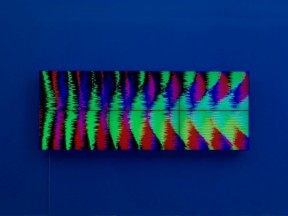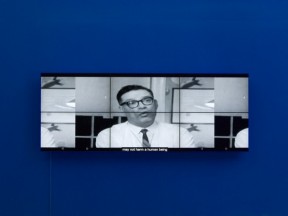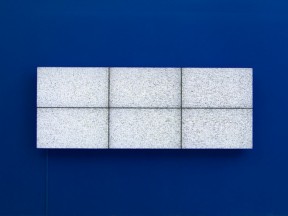The Static Generation
aaajiao: “The Screen Generation”
C-Space (Road No.1—C1 & C2 Caochangdi Chaoyang District Beijing, China) Nov 3–Dec 1, 2013
chi K11 Art Space (Shanghai K11 Art Mall, B3, 300 Huaihai Zhong Lu, Shanghai, China), Dec 14, 2013–Feb 15, 2014
An effective and detailed essay accompanying Aaajiao’s recent solo show at C-Space discusses the idea of “coinciding aspects of human and screen,” seeking to do away with the impression of digital screens (the kind an increasing portion of humanity uses daily) as simply emitting or “self-displaying” outwards. Instead, Aaajiao (Xu Wenkai)—whose background is not in fine art, but computer programming—is apparently looking into how screen/machine and viewer are mutually constituted. The work next appears in Shanghai from 14th December at the new “chi K11 Art Space.”
Aaajiao’s presentation at C-Space was simple—a blue-painted room and, on one wall, six large screens hung together in a rectangle of three by two. They simultaneously displayed one of six looped videos called “Soft,” “Repeatedly,” “Hard,” “Pure,” “Static” and “Noise.” “Static,” for example, is the artist’s reconstruction of a fuzzy black and white screen; “Repeatedly” is a white ground with black flecks, and “Hard” replays parts of a recording of the scientist Isaac Asimov talking about robotics. The most compelling, “Soft,” shows just blue screens mimicking the wall color with a lighter blue field moving slowly across them, vessel-like. These videos are defined as individual works, though the way they were seen in succession, coupled with the feeling of the blue-painted space as an overarching environment and part of the installation, made it feel like a single, unfolding piece. The environment thus created was at once immersive and somewhat distancing—retaining the familiarity and what might be admitted as the sensory “comfort” of focusing on a screen, but surrounding one nonetheless with an abstract, minimal atmosphere. The dynamics of human contact with screens and their conflicting promises of entertainment, work, communication and more seem to be played upon by Aaajiao.
One cannot help but find a philosophical inflection in this show and the text about it, musing as it does upon the relationship between man and machine and, indeed, to quote the essay “What is ‘human’ in relation to Aaajiao’s works?” The results (and therefore, implicitly, the existence) of the screens are sought in the human encounter with and reaction to them, which—surely not coincidentally—is not far away from theories about the identity of a work of art in relation to an audience. In the contemporary age, when people are so bound to their screens and devices, and when so many of the choices that help define them are enacted through these, the screen indeed becomes a human medium in some form; McLuhan understood the contents of one medium simply as other media. In Aaajiao’s conception, there is the uncanny suggestion that humans then become the media of which the screens are composed, and vice-versa. Perhaps, more than being just human-orientated, as the essay suggests, one might make the leap to understand something more happening. Add the idea of a blue screen as meaning either the beginning of a program or system crash, and you have metaphors for life and death.
But this is a great and rapid leap—from blue walls and six screens to life and death. Is this really something the work has achieved? Something appears to have been set up here, but arguably, nothing is actually done. Perhaps it is symptomatic of the very fascination of the screen that such a step is so easy. One could claim that this show leans entirely on the aestheticization of a functional object. Put another way, it is compelling because it combines a certain minimal look associated with fine art with the attraction, even seduction, of smoothly functioning computer monitors. One might struggle, without the support of the accompanying text—to say what the actual “content” of this installation is. Questions like these call on a distinction made usefully by the new media theorist Lev Manovich between what he refers to “Duchamp-land” (meaning contemporary art) and “Turing-land” (computer arts). To Manovich’s mind, Duchamp-land takes art to be self-referential, “complicated” and focused on content; computer-art, on the other hand, is “simple”—ie., not ironic, orientated towards new technology rather than content and, last but not least, takes that technology seriously, never questioning its ability or revealing its flaws. In this light, Aaajiao’s “Screen Generation” seems less like Duchamp-land fine-art fit for a gallery than highly-finished computer art fit for appraisal as such—a clean, refined presentation not necessarily without philosophical ramifications, but appreciable essentially for its technological properties and refinement.
Debates about new media art and even post-internet art continue, and the reference to such debates made here is necessarily brief. This is not to dismiss this show by Aaajiao, but it is to request a moment of pause. Sweeping though the onset of technology into daily human life is, reactions to it should still be recognized as personal. Inadvertently, the exhibition raises the importance of human agency—whether looking at technology, or art.
2014.01.23 Thu, by Iona Whittaker Translated by: 路弯弯 Check out Randian website here




 Back to Index
Back to Index